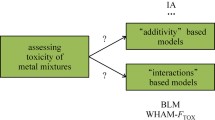Abstract
The partial least squares(PLS) method was employed to establish a quantitative ion characteristics-activity relationship(QICAR) model for metal ion toxicity(EC50 of 15 metal ions). The ion characteristics included AN(the atomic number), ΔIP(the change in ionization potential, eV), X m(the electronegativity, eV), AW(the atomic weight), X m 2 r(the covalent index), ΔE 0(the absolute difference between electrochemical potential of the ion and that of its first stable reduced state, eV), |lgK OH|(the absolute value of the lg of the first hydrolysis constant), AR(the atomic radius, nm), AR/AW(the ratio between atomic radius and atomic weight) and σ p(the softness index) selected based on relative correlation analysis. The simulated and tested(with the other four metals) efficiency coefficients of the model are 0.88 and 0.96, respectively. The information revealed from the QICAR model indicates that the value of the metal ion toxicity was positively correlated with variables AN, ΔIP, X m, AW and X m 2 r; negatively correlated with variables ΔE 0, |lgK OH|, AR/AW, AR and σ p, and ion characteristics ΔE 0, X m, σ p and X m 2 r were found to contribute more to the toxicity of metal ions via the accurate analysis method provided by PLS. The model could be used to predict the toxicity of the target metals and preliminary to assess combined pollution and environmental risk for heavy metals in the environments.
Similar content being viewed by others
References
Wei B. G., Jiang F. Q., Li X. M., Mu S. Y., Micro Chemical Journal, 2011, 93(2), 147
Fisher N. S., Limnology and Oceanography, 1986, 31(2), 443
Magwood S., George S., Marine Environmental Research, 1996, 42(14), 37
Tatara C. P., Newman M. C., McCloskey J. T., Williams P. L., Aquat Toxicol., 1997, 39(3/4), 279
Newman M. C., McCloskey J. T., Tatara C. P., Environ Health Perspect, 1998, 106(Suppl. 6), 1419
Mccloskey J. T., Newman M. C., Environ. Toxicol Chem., 1996, 15(10), 1730
Wolterbeek H. T., Verburg T. G., Sci. Total Environ., 2001, 279(1–3), 87
Kaiser K. L. E., Molecular Informatics, 2003, 22(2), 185
Capitani J. F., Di Toro D. M., Center for the Study of Metals in the Environment—Annual Report Submitted to US Environmental Protection Agency, Washington, 2004, 84
Zhou D. M., Li L. Z., Peijnenburg W. J., Ownby D. R., Hendriks A. J., Wang P., Li D. D., Bioresour Technology, 2011, 74(4), 1036
Ownby D. R., Newman M. C., QSAR Comb. Sci., 2003, 22(2), 241
Tatara C. P., Newman M. C., McCloskey J. T., Williams P. L., Auqat Toxicol., 1998, 42(4), 255
Kaiser K. L. E., Canadian Journal of Fisheries and Aquatic Sciences, 1980, 37(2), 211
Kaiser K. L. E., Science of the Total Environment, 1985, 46(1–4), 113
Wold H.; Ed.: Krishnaiah P. R., Multivariate Analysis, Academic Press, New York, 1966, 391
Wold H., Journal of Marketing Research, 1982, 19(4), 440
Rapp A., Trainor K. J., Agnihotri R., Journal of Business Research, 2010, 63(11), 1229
Ringle C. M., Saratedt M., Straub D. W., MIS Quarterly, 2012, 36(1), 3
Okazaki S., Taylor C. R., Journal of Business Research, 2008, 61(1), 4
Fang Y. Y., Wang X., Li H. Y., Ma Y., Yuan M. X., Huang R. Q., Lai C. M., Chem. J. Chinese Universities, 2001, 22(4), 587
Zhu C., Huang M., Liang Q. L., Wang Y. M., Hu P., Li P., Zhang H. J., Lu X. G., Luo G. A., Chem. J. Chinese Universities, 2011, 32(7), 1512
Dong J. Y., Deng L. L., Cheng K. K., Griffin J. L., Chen Z., Chem. J. Chinese Universities, 2011, 32(12), 2769
Hair J. F., Ringle C. M., Sarstedt M., Journal of Marketing Theory and Practice, 2011, 19(2), 139
Martens H., Chemometrics and Intelligent Laboratory Systems, 2001, 58(2), 85
Anjali K., Lynne J. W., Anthony R. M., Hervé A., Neurolmage, 2011, 56(2), 455
Wold S., Sjöström M., Eriksson L., Chemometrics and Intelligent Laboratory Systems, 2001, 58(2), 109
Eldén L., Computational Statistics & Data Analysis, 2004, 46(1), 11
Du X. Y., Liu J. L., Li Y., Fresen Environ. Bull., 2011, 20(1), 121
Danielli J. F., Davies J. F., Advances in Enzymology and Related Areas of Molecular Biology, 1951, 11, 35
Dingstad G. I., Westad F., Næs T., Chemometrics and Intelligent Laboratory Systems, 2004, 71, 33
Abdul-Wahab S. A., Bakheit C. S., Al-Alawi S. M., Environmental Modelling & Software, 2005, 20(10), 1263
Cash G. G., Breen J. J., Chemosphere, 1992, 24(11), 1607
Wang H. W., Wu Z. B., Meng J., Partial Least-Squares Regression-Linear and Nonlinear Methods, National Defence Industry Press, Beijing, 2006, 307
Zamil S. S., Ahmad S., Choi M. H., Park J. Y., Yoon S. C., Bioresource Technology, 2009, 100(6), 1895
Author information
Authors and Affiliations
Corresponding author
Additional information
Supported by the Key Projects in the National Science & Technology Pillar Program in the Eleventh Five-Year Plan Period, China(No.2008BAC43B01).
Rights and permissions
About this article
Cite this article
Li, Y., Jiang, L., Li, Xl. et al. A QICAR model for metal ion toxicity established via PLS method. Chem. Res. Chin. Univ. 29, 568–573 (2013). https://doi.org/10.1007/s40242-013-2244-2
Received:
Accepted:
Published:
Issue Date:
DOI: https://doi.org/10.1007/s40242-013-2244-2




